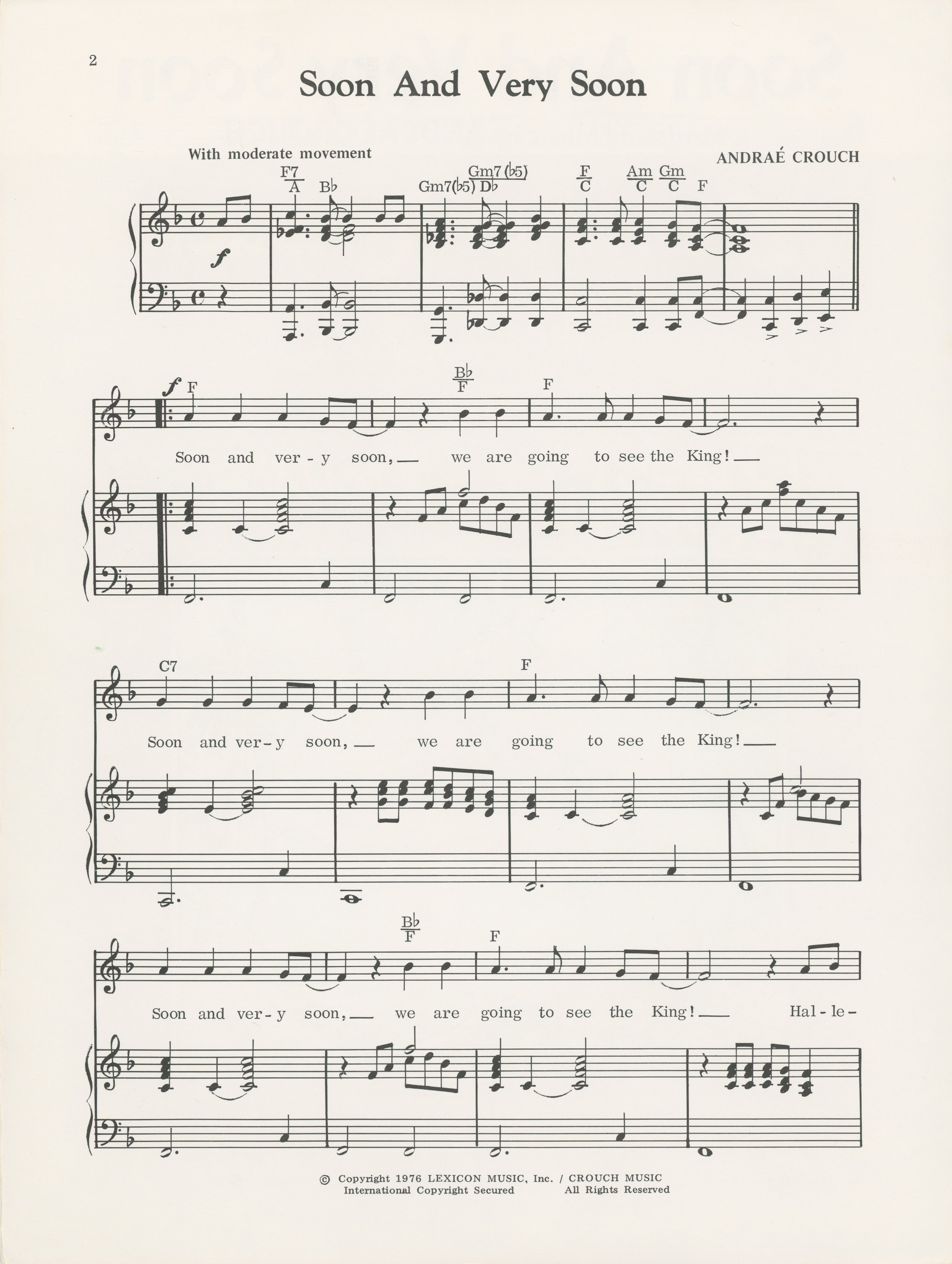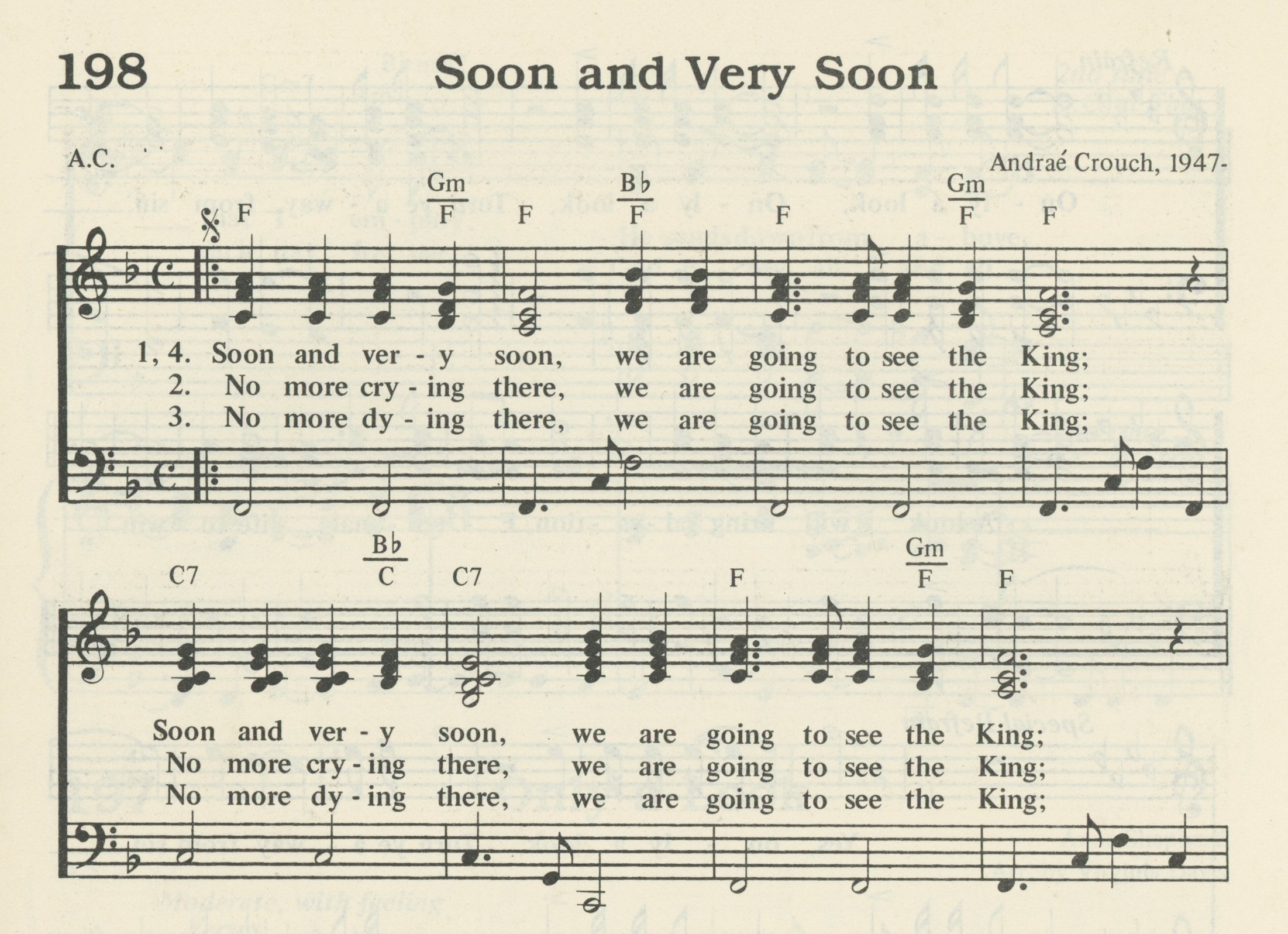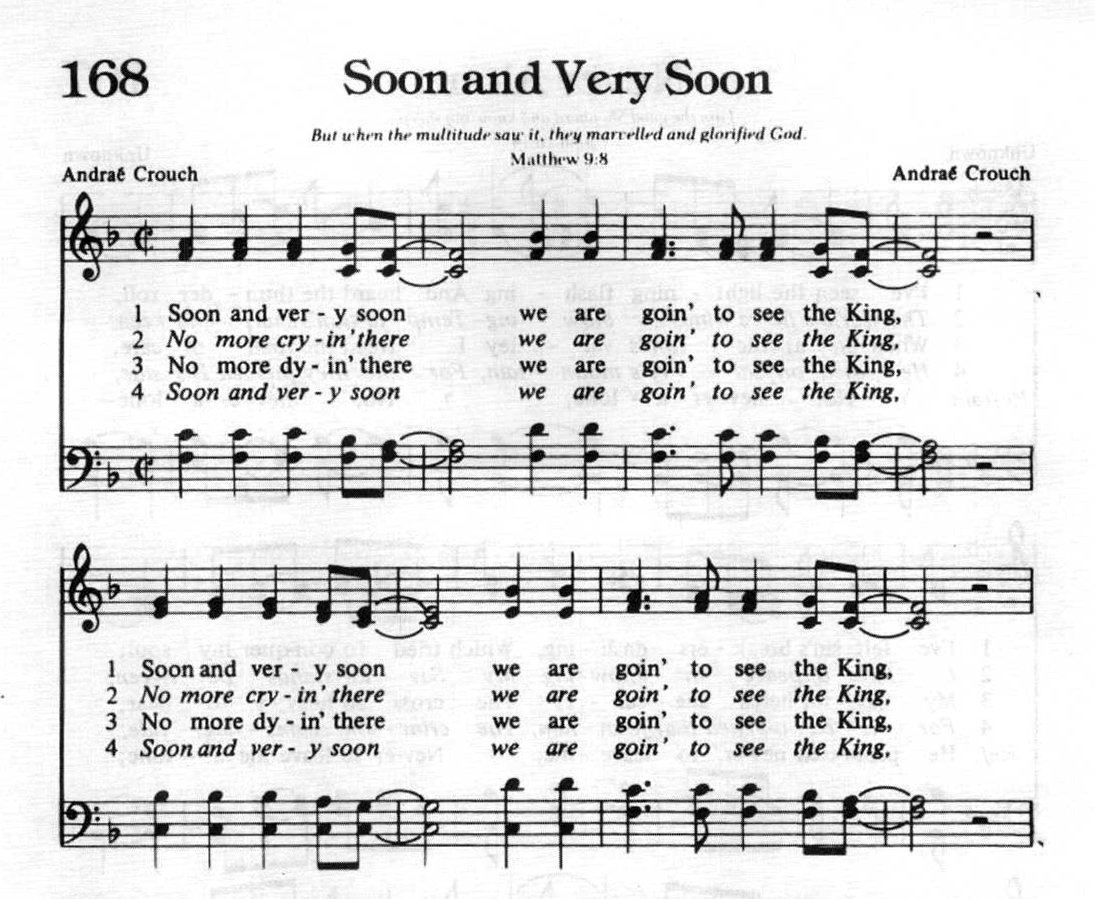Soon and Very Soon
I. Origins
In 1976, Andraé Crouch (1942–2015) was a darling of the gospel music industry, having scored a string of successful songs, including “The Blood Will Never Lose Its Power,” “Through It All,” and “My Tribute.” He had also published an autobiography, titled Through It All (1974). His songs were starting to make their way into congregational hymnals such as Hymns for the Family of God (1976) and the New Church Hymnal (1976). That year, he released the sixth album with his backing group, the Disciples, This Is Another Day (Light LS-5683). The most popular song from that album was “Soon and Very Soon.”
The song was released as sheet music via Lexicon Music, the publishing arm of his record company, then included in the album’s songbook (1978) and in a compilation songbook, Songs of Andraé Crouch and the Disciples (1979). The copyright for the album was registered on 4 Oct. 1976, and the copyright for the score was registered on 26 Oct. 1976. A 45-rpm single was issued as Light LS-623.
Fig. 1. “Soon and Very Soon” (Waco, TX: Lexicon, 1976), excerpt.
In its original form, the song has two additional stanzas, “No more crying there” and “No more dying there,” and a bridge beginning “Should there be any rivers we must cross.” The original sheet music was melody-only, lacking the choral harmonization, and the piano scoring should be regarded as a bare-bones representation of the accompaniment, not an accurate representation of Crouch’s playing.
Additional recordings include Bill & Gloria Gaither’s Kennedy Center Homecoming (1999), which was released as a CD and DVD, and Crouch’s final album, Live in Los Angeles (2011/13), also released on CD and DVD.
On 7 July 2009, the Andraé Crouch Singers performed “Soon and Very Soon” for a memorial tribute to Michael Jackson, recorded live at the Staples Center in Los Angeles. Crouch himself did not appear on camera for the performance, and the pianist for the group was not identified.
II. Early Congregational Publications
The song’s adoption into congregational hymnals and songbooks has led to varying approaches in arranging a condensed score to allow for harmony and basic accompaniment, with concerns for traditional hymnal arranging and for the space and vocal resources required to accommodate the solo bridge. In most congregational songbooks, the song is not printed with the bridge.
The song’s first appearance in a congregational songbook was in the National Baptist collection Free Spirit (1979 | Fig. 2), where it was printed in full and set in four-part harmony. The arrangement was credited “©1977 by Crouch Music.” When it appeared in the United Methodist supplement Songs of Zion (1981 | Fig. 3), it was again given in full, but with voice parts only in the treble clef, mostly in three parts, at times questionably extended into four and five parts, while also squaring the rhythms of the melody. Similar versions appeared in the Hymnal for Worship and Celebration (1986 | Fig. 4), stanzas only, with corrected rhythms, and in Sing Joyfully! (1989) with stanzas and hallelujahs.
Fig. 2. Free Spirit (Nashville: National Baptist Publishing Board, 1979), excerpt.
Fig. 3. Songs of Zion (Nashville: Abingdon, 1981), excerpt.
Fig. 4. Hymnal for Worship and Celebration (Waco, TX: Word, 1986).
A congregational, four-part setting appeared in the COGIC hymnal Yes, Lord! (1982 | Fig. 5), omitting the bridge but keeping the extra hallelujahs. A congregational harmonization by William Farley Smith, made for the United Methodist Hymnal (1989 | Fig. 6), has been repeated in other hymnals. Smith’s arrangement utilizes different harmonic progressions in some places and adds transitional bass figures.
Fig. 5. Yes, Lord! (Memphis: Church of God in Christ, 1982).
Fig. 6. United Methodist Hymnal (Nashville: United Methodist Publishing House, 1989).
III. Analysis
Aside from the bridge, the song has qualities reminiscent of a modern-day spiritual, because it has a simple text, a word-substitution format, and an inner refrain (“we are going to see the King”), making it suitable for singing easily from memory. The lines “No more crying there” and “No more dying there” are called wandering verses, because they are borrowed from other traditional songs. Most notably, the song has much in common with an earlier American spiritual, “Come and go with me to my Father’s house,” which speaks of a future in heaven, has a similar harmonic structure in the first three phrases (I–V–I), uses the word-substitution format, and has an inner refrain. A popular adaptation of the spiritual made by Edwin Hawkins, recorded on his album Let Us Go into the House of the Lord (1968), includes the phrase “There’ll be no crying there; there’ll be no dying there.”
Like the spiritual, Crouch’s song conveys sentiments found in Revelation 21:3–4, “Behold, the dwelling place of God is with man. He will dwell with them, and they will be his people, and God himself will be with them as their God. He will wipe away every tear from their eyes, and death shall be no more, neither shall there be mourning, nor crying, nor pain anymore, for the former things have passed away” (ESV), and it echoes the promise of Revelation 22:7, “I am coming soon.”
The editors of Sing! A New Creation: Leader’s Edition (2002) offered a summary of the song’s message and advice for performance:
This text is filled with exuberant joy and eschatological hope. This song revels in the promise of paradise—eternal communion with the King—where there will be no more hurting or crying or dying. Sing with confidence, like those who have left for a long-anticipated journey to a wonderful place: before we arrive, our hearts are already there.[1]
Episcopal hymnist Carl Daw viewed the hymn in contrast to apocalyptic hymns about the Second Coming (such as the Dies Irae, or John Newton’s “Day of judgment! Day of Wonders!”):
Especially when coupled with the “Hallelujah” refrain, the tone is full of excitement and joyful expectation, a far cry from the fearful attitudes that once characterized portrayals of Christ’s return. Christ is no longer the forbidding Judge but the consoling and life-bestowing King.[2]
Regarding the song’s bridge and the cultural context of the song, Gwendolyn Sims Warren noted:
In addition to the hope of a better life to come, there is a great universal appeal to Christians from all walks of life in this song, which declares, “We have come from every nation” and “God knows each of us by name.” Not only do these lines symbolize the unity of those who believe in the same God and the same good news of the gospel message, but they stress the individuality and importance of each believer to God, in that He knows us by name. The King who is sung about in this song is not an impersonal God; He is one who cares enough to know each of His children by name.
There is great comfort in that to those who look forward to seeing Him one day. It is especially meaningful to those who, for whatever reason, may have been treated as unimportant in this lifetime. Whether struggling under the bondage of slavery or the deprivation of the depression, or marching in freedom marches in an attempt to gain the rights and privileges that are supposed to be possessed by all citizens of this country, African-Americans have had to fight to maintain their dignity. To be treated as second-class citizens—or, indeed, as less than citizens at all—only reinforces the need to be recognized as one with worth. In declaring that the King knows each of us by name, that worth is affirmed in a way no amount of human acceptance can bestow.[3]
by CHRIS FENNER
for Hymnology Archive
23 September 2022
Footnotes:
Gwendolyn Sims Warren, “Soon and Very Soon,” Ev’ry Time I Feel the Spirit (NY: Henry Holt & Co., 1997), p. 330.
“Soon and Very Soon,” Sing! A New Creation: Leader’s Edition (Grand Rapids: Faith Alive, 2002), no. 106.
Carl P. Daw Jr., “Soon and Very Soon,” Glory to God: A Companion (Louisville: Westminster John Knox, 2016), p. 391.
Additional Sources:
Diana Sanchez, ed., “Soon and Very Soon,” The Hymns of the United Methodist Hymnal (Nashville: Abingdon, 1989), p. 235–236.
Gordon L. Borror, “Soon and Very Soon,” The Worshiping Church: Worship Leaders’ Edition (Carol Stream, IL: Hope, 1990), no. 677.
Paul A. Richardson, “Soon and Very Soon,” Handbook to the Baptist Hymnal (Nashville: Convention Press, 1992), pp. 234–235.
Carlton R. Young, “Soon and Very Soon,” Companion to the United Methodist Hymnal (Nashville: Abingdon, 1993), pp. 602–603.
Marilyn Kay Stulken, “Soon and Very Soon,” With One Voice Reference Companion (Minneapolis: Augsburg Fortress, 2000), p. 98.
Edward Darling and Donald Davison, “Soon and Very Soon,” Companion to Church Hymnal (Dublin: Columba, 2005), p. 219–220.
Paul Westermeyer, “Soon and Very Soon,” Hymnal Companion to Evangelical Lutheran Worship (Minneapolis: Augsburg Fortress, 2010), p. 261.
C. Michael Hawn & J.R. Watson, “Soon and Very Soon,” Canterbury Dictionary of Hymnology: http://www.hymnology.co.uk/s/soon-and-very-soon
“Soon and Very Soon,” Hymnary.org: https://hymnary.org/text/soon_and_very_soon_we_are_going






